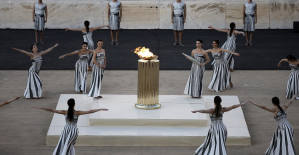Architecture is always political, that is now well known. This is why exhibitions about architecture are also required to critically question their social effects. Preferably already in the exhibition design.
The show "Ole Scheeren: Spaces of Life", which has just opened at the ZKM in Karlsruhe, does this very explicitly: in the center of the huge room in the former ammunition factory is the "media dump", a kind of multimedia torture rondel, on which brutal screens hung close together Scheeren's architecture is negotiated.
You sit in the middle and are bombarded from all sides by social media posts, micro-statements, countless individual criticisms with which Ole Scheeren's work is addressed in the media. In between, a stylish photo of the naturally very good-looking architect himself flickers, but it immediately disappears again, washed away by the never-ending stream of new pictures and statements.
Building as a hypermedia spectacle that leaves little room for quiet reflection - an apt statement on the role of architecture in the age of social media. And one that almost self-reflectively anticipates and thus neutralizes the criticism that a star architect like Scheeren, who builds primarily in Asia, sees himself exposed to, especially in the German architectural discourse.
The work of the native of Karlsruhe is fascinating, but is also viewed ambivalently. In Europe and especially in Germany he hasn't really been able to gain a foothold. But Scheeren is realizing highly acclaimed skyscrapers worldwide, from Bangkok and Singapore to Beijing and Vancouver.
His built giants think further of what a skyscraper can be; they question the modernist basic assumption of building construction as an isolated urban monolith and create connections, take up the references of the urban space and write them further in the building. But they are also – well, skyscrapers.
You are tall. They use a lot of building mass. And they are often just singular buildings. For some, this seems problematic at a time when it is considered progressive (keyword sustainability debate) to ask whether one is still allowed to build at all.
The answer that Ole Scheeren gave unequivocally in Karlsruhe is: You're not only allowed to. You even have to. People want spatially defined stories, want the spaces in which they live to be rethought through self-confident architectural interventions.
The great is not necessarily hierarchical. It can also serve to create new communities. The designers of the large structures of the 1970s knew this. This thought is regularly reflected in Ole Scheeren's work, for example in the "King Power Mahanakhon Tower" in Bangkok. The apparently broken project takes up the structures of the surrounding city and continues them in the vertical.
At a spectacular height of 314 meters, the learned neutral shell of the skyscraper principle is dissolved and a piece of human scale is made visible in a three-dimensional pixel spiral. On the roof terrace, visitors can look back at the city and observe the references of the architecture in the urban space from afar, just as people on the street can get a glimpse of life in the tower from a distance.
Of course it has to be said: Seeing is not the same as living. Scheeren's large buildings negotiate the relationship between public and private, but are not grassroots products. They are not social buildings, not architecture for the masses. But what they do: They develop templates for how architecture can create social spaces.
For example, in the “Interlace” mega-project, which Scheeren implemented in cooperation with his former employer Rem Koolhaas. On a total of 170,000 square meters, this represents a multiply stacked vertical village with living and communal areas, which creates many very different social spaces and, above all, draws the surrounding lush vegetation and nature into the extremely dense megastructure.
A structural statement that seeks new ways to combine density and quality of stay in the rapidly growing Asian metropolises. Perhaps not a “prototype for the life of tomorrow”, as the exhibition's accompanying material puts it somewhat pompously. But an exciting statement on the question of what such prototypes have to achieve and how they can create community.
Because one tends to forget that when looking at large structures too abstractly: that they can bring people together if they are designed sensibly. This is what constitutes the sensual-emotional component of architecture. In the very rational and often somewhat contrite German architectural discourse, this is often forgotten.
The exhibition in Karlsruhe is a plea for this. With huge models of Scheeren's iconic buildings. With augmented reality extensions, which, as always, are a bit clumsy to use, but make it comprehensible in an attractive way how people move through the buildings, how they appropriate them.
And also through the many loving drawings that show how Scheeren's structural giants around the world bring people together in ever new constellations. Architecture tells stories. The writer and GenX pioneer Douglas Coupland, who is present in Karlsruhe with fictitious letters from building users, also knows this.
Writers who are inspired by large buildings, sociologists who arrive at new interpretations of society through architecture – the joy of crossing disciplinary boundaries is celebrated in Karlsruhe. It was not for nothing that the media philosopher and longtime director of the ZKM, Peter Weibel, conceived and curated the show together with Scheeren.
The joy of this expanded view of architecture peaked ten to twenty years ago, when Rem Koolhaas inspired university seminars on cultural studies and Peter Sloterdijk gave lectures at architects' association days. In the course of the climate debate (as I said, are we still allowed to build at all?), this enthusiasm has dried up somewhat.
The Karlsruhe show and the various thinker statements accompanying it therefore have something slightly nostalgic about them. What if architecture and thinking about it could be really fun again? That's what Ole Scheeren asks with his exhibition. And that is, despite all the hardships and constraints of the present time, a justified, a good question.

 War in Ukraine: when kyiv attacks Russia with inflatable balloons loaded with explosives
War in Ukraine: when kyiv attacks Russia with inflatable balloons loaded with explosives United States: divided on the question of presidential immunity, the Supreme Court offers respite to Trump
United States: divided on the question of presidential immunity, the Supreme Court offers respite to Trump Maurizio Molinari: “the Scurati affair, a European injury”
Maurizio Molinari: “the Scurati affair, a European injury” Hamas-Israel war: US begins construction of pier in Gaza
Hamas-Israel war: US begins construction of pier in Gaza First three cases of “native” cholera confirmed in Mayotte
First three cases of “native” cholera confirmed in Mayotte Meningitis: compulsory vaccination for babies will be extended in 2025
Meningitis: compulsory vaccination for babies will be extended in 2025 Spain is the country in the European Union with the most overqualified workers for their jobs
Spain is the country in the European Union with the most overqualified workers for their jobs Parvovirus alert, the “fifth disease” of children which has already caused the death of five babies in 2024
Parvovirus alert, the “fifth disease” of children which has already caused the death of five babies in 2024 Inflation rebounds in March in the United States, a few days before the Fed meeting
Inflation rebounds in March in the United States, a few days before the Fed meeting Video games: Blizzard cancels Blizzcon 2024, its annual high mass
Video games: Blizzard cancels Blizzcon 2024, its annual high mass Falling wings of the Moulin Rouge: who will pay for the repairs?
Falling wings of the Moulin Rouge: who will pay for the repairs? “You don’t sell a company like that”: Roland Lescure “annoyed” by the prospect of a sale of Biogaran
“You don’t sell a company like that”: Roland Lescure “annoyed” by the prospect of a sale of Biogaran Exhibition: in Deauville, Zao Wou-Ki, beauty in all things
Exhibition: in Deauville, Zao Wou-Ki, beauty in all things Dak’art, the most important biennial of African art, postponed due to lack of funding
Dak’art, the most important biennial of African art, postponed due to lack of funding In Deadpool and Wolverine, Ryan and Hugh Jackman explore the depths of the Marvel multiverse
In Deadpool and Wolverine, Ryan and Hugh Jackman explore the depths of the Marvel multiverse Tom Cruise returns to Paris for the filming of Mission Impossible 8
Tom Cruise returns to Paris for the filming of Mission Impossible 8 Skoda Kodiaq 2024: a 'beast' plug-in hybrid SUV
Skoda Kodiaq 2024: a 'beast' plug-in hybrid SUV Tesla launches a new Model Y with 600 km of autonomy at a "more accessible price"
Tesla launches a new Model Y with 600 km of autonomy at a "more accessible price" The 10 best-selling cars in March 2024 in Spain: sales fall due to Easter
The 10 best-selling cars in March 2024 in Spain: sales fall due to Easter A private jet company buys more than 100 flying cars
A private jet company buys more than 100 flying cars This is how housing prices have changed in Spain in the last decade
This is how housing prices have changed in Spain in the last decade The home mortgage firm drops 10% in January and interest soars to 3.46%
The home mortgage firm drops 10% in January and interest soars to 3.46% The jewel of the Rocío de Nagüeles urbanization: a dream villa in Marbella
The jewel of the Rocío de Nagüeles urbanization: a dream villa in Marbella Rental prices grow by 7.3% in February: where does it go up and where does it go down?
Rental prices grow by 7.3% in February: where does it go up and where does it go down? Even on a mission for NATO, the Charles-de-Gaulle remains under French control, Lecornu responds to Mélenchon
Even on a mission for NATO, the Charles-de-Gaulle remains under French control, Lecornu responds to Mélenchon “Deadly Europe”, “economic decline”, immigration… What to remember from Emmanuel Macron’s speech at the Sorbonne
“Deadly Europe”, “economic decline”, immigration… What to remember from Emmanuel Macron’s speech at the Sorbonne Sale of Biogaran: The Republicans write to Emmanuel Macron
Sale of Biogaran: The Republicans write to Emmanuel Macron Europeans: “All those who claim that we don’t need Europe are liars”, criticizes Bayrou
Europeans: “All those who claim that we don’t need Europe are liars”, criticizes Bayrou These French cities that will boycott the World Cup in Qatar
These French cities that will boycott the World Cup in Qatar Basketball: Strasbourg appeals the victory recovered by Monaco
Basketball: Strasbourg appeals the victory recovered by Monaco Top 14: UBB with Tatafu and Moefana against Bayonne
Top 14: UBB with Tatafu and Moefana against Bayonne MotoGP: Bagnaia dominates qualifying practice in Spain and sets track record
MotoGP: Bagnaia dominates qualifying practice in Spain and sets track record Olympic Games: in Athens, Greece transmits the Olympic flame to France
Olympic Games: in Athens, Greece transmits the Olympic flame to France


















